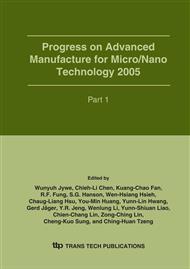p.19
p.25
p.31
p.37
p.43
p.49
p.55
p.61
p.67
Determination of Residual Resist Layer Thickness in E-Beam Lithography Based on Energy Dispersive X-Ray Spectrometer
Abstract:
In this paper, we report a method for determining the residual thickness of resist layer during e-beam lithography processes. The method is based on the energy dispersive x-ray spectroscopic (EDS) measurements on a silicon substrate deposited with a PMMA layer. The PMMA layer acts as the resist layer in e-beam lithography. From a calibration test, an empirical relationship is established between the EDS signal, electron energy, and PMMA film thickness. Form this empirical relationship the residual PMMA layer thickness after e-beam exposure and developing can be determined within an accuracy of 83%, which is very important to the subsequent etching processes. An important feature of the proposed method is that its lateral resolution depends only on the focused e-beam spot size and can be in the order of nm. With such resolution, the thickness of the resist layer under few nm line width can be measured. The proposed method to estimate the residual resist layer thickness plays a vital role in nano-fabrication or nano-patterning based on e-beam lithography technology.
Info:
Periodical:
Pages:
43-48
Citation:
Online since:
January 2006
Authors:
Price:
Сopyright:
© 2006 Trans Tech Publications Ltd. All Rights Reserved
Share:
Citation:


